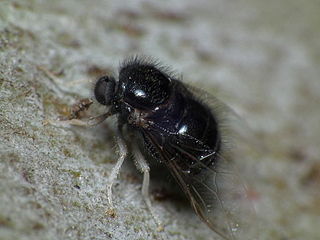
The Mygalomorphae, or mygalomorphs, are an infraorder of spiders, and comprise one of three major groups of living spiders with over 3,000 species, found on all continents except Antarctica. Many members are known as trapdoor spiders due to their creation of trapdoors over their burrows. Other prominent groups include Australian funnel web spiders and tarantulas, with the latter accounting for around one third of all mygalomorphs.

The Acroceridae are a small family of odd-looking flies. They have a hump-backed appearance with a strikingly small head, generally with a long proboscis for accessing nectar. They are rare and not widely known. The most frequently applied common names are small-headed flies or hunch-back flies. Many are bee or wasp mimics. Because they are parasitoids of spiders, they also are sometimes known as spider flies.

Nemestrinoidea is a small, monophyletic superfamily of flies, whose relationship to the other Brachycera is uncertain; they are sometimes grouped with the Tabanomorpha rather than the Asilomorpha. They are presently considered to be the sister taxon to the Asiloidea. The group contains two very small extant families, the Acroceridae and Nemestrinidae, both of which occur worldwide but contain only small numbers of rare species. One extinct family, Rhagionemestriidae, is also included in Nemestrinoidea.

Acrocerinae is a subfamily of small-headed flies in the family Acroceridae. Their larvae are endoparasites of araneomorph spiders, with the exception of Carvalhoa appendiculata which can develop as ectoparasitoids on their host spiders. Traditionally, the subfamily included the genera now placed in Cyrtinae and Ogcodinae, but the subfamily in this sense was found to be polyphyletic and was split up in 2019.
The Hilarimorphidae or hilarimorphid flies are a family of Diptera. They are of uncertain placement and may be related to the Acroceridae. Most species are Nearctic.

Philopotinae is a subfamily of small-headed flies. They have an arched body shape, as well as enlarged postpronotal lobes that form a collar behind the head. Their larvae are endoparasites of araneomorph spiders in the subgroup Entelegynae.

Panopinae is a subfamily of small-headed flies (Acroceridae). Their larvae are endoparasites of spiders in the infraorder Mygalomorphae.

Acrocera orbiculus, also known as the top-horned hunchback, is a species of fly belonging to the family Acroceridae. The species has a holarctic distribution, ranging from North America to the Palaearctic.

Acrocera is a genus of small-headed flies in the family Acroceridae.
Acrocera subfasciata is a species of small-headed flies in the family Acroceridae.

Ogcodes is a cosmopolitan genus of small-headed flies in the family Acroceridae. About 90 species have been described for the genus. It is the most common and speciose genus in its family. These flies are endoparasitoids of ground-dwelling entelegyne spiders.
Acrocera unguiculata is a species of small-headed flies in the family Acroceridae.
Acrocera obsoleta is a species of small-headed flies in the family Acroceridae.

Pterodontia is a genus of small-headed flies. There are at least 20 described species in Pterodontia.
Ocnaea is a genus of small-headed flies. There are 20 described species in Ocnaea.
Acrocera bimaculata is a species of small-headed flies in the family Acroceridae.
Pterodontia johnsoni is a species of small-headed flies.
Ogcodes eugonatus is a species of small-headed flies.
Apelleia is a genus of small-headed flies. It differs from Ocnaea by its glabrous eyes.

Psilodera fasciata, also known as the banded humpback fly, is a species of small-headed fly found in South Africa. It is the most common species in its genus.







